Physical Address
304 North Cardinal St.
Dorchester Center, MA 02124
The multiple endocrine neoplasia (MEN) syndromes occur as a result of a genetic change leading to the development of tumors in endocrine organs and tissues. Alterations in the menin gene, a tumor suppressor gene, results in MEN type 1 (MEN1), while MEN type 2 (MEN2) occurs as a result of changes in the RET proto-oncogene. This results in both benign and malignant endocrine tumors, and the individual possessing a mutation in either is at lifelong risk of development of these tumors. Each of the MEN syndromes is clinically characterized by the phenotypic expression of specific tumors. Strategies for management include screening for the presence of a mutation in some cases as well as follow-up and management directed specifically at the involved structure or organ. This may include prophylactic surgery, in the case of medullary thyroid cancer (MTC) in the setting of MEN2, or surveillance, for example, for pancreatic neuroendocrine tumors (PNETs) in MEN1.
The type of endocrine tumors that develop follows a pattern specific to each syndrome. MEN1 is characterized by the presence of parathyroid adenomas in multiple glands, neuroendocrine tumors (NETs) of the gastrointestinal system and pancreas, and adenomas of the pituitary gland. While these are the most frequently occurring tumors within the syndrome, carriers may also develop carcinoid tumors of the thymus, facial angiofibromas, adrenal adenomas, lipomas, and collagenomas. MEN2 is further subdivided into types A and B. Patients with MEN2A have MTC or thyroid C-cell hyperplasia, pheochromocytomas, and parathyroid tumors. Those with MEN2B also have MTC or thyroid C-cell hyperplasia and pheochromoctyomas, as well as mucosal neuromas, ganglioneuromatosis of the gastrointestinal tract, and a distinct appearance referred to as marfanoid.
Like other genetic syndromes, MEN1 is relatively rare among the general population, occurring in 1 of 30,000 people. In patients with primary hyperparathyroidism (PHPT), it occurs in 1% to 18%, while patients with pituitary adenomas have MEN1 less than 3% of the time. The presence of MEN1 varies in patients with NETs depending on type. It is distributed across all ages, ranging from 9 to 77. Typically, the clinical manifestations of MEN1 will have developed by age 29. Overall survival in carriers is 82% with a disease-specific survival of 88% at 30 years with a mean age at death of 50 to 55 years.
MEN1 is a hereditary cancer syndrome inherited in an autosomal dominant manner. Prior to the discovery of the genetic abnormality responsible for development of the MEN1 syndrome, also called Wermer syndrome, the diagnosis was made clinically. Commercial testing for the mutation has now been available for a little over 30 years. The syndrome MEN1 develops as a result of a germline mutation and loss of heterozygosity in the MEN1 gene in target tissue, leading to the development of tumors. The gene encodes the protein menin, which functions as a tumor suppressor in target tissues. By definition, tumor suppressor genes encode for proteins that regulate cell growth and proliferation. Loss of function of a tumor suppressor gene results in cell proliferation and, in turn, neoplastic transformation. Menin would normally participate in transcriptional regulation, DNA repair, and cell signaling, and mutations lead to a nonfunctioning protein. In the “two-hit” hypothesis of tumor development, a mutation is inherited as a germline mutation, thereby making involved tissues or organs susceptible to growth of neoplasms. The remaining normal or functional gene then undergoes a somatic mutation, or a “second hit,” thus resulting in cancer development ( Fig. 41.1 ). This process is described as loss of heterozygosity whereby a cell with the germline mutation receives a second hit to the functional copy becoming homozygous and resulting in disruption of the function of the normally produced protein.
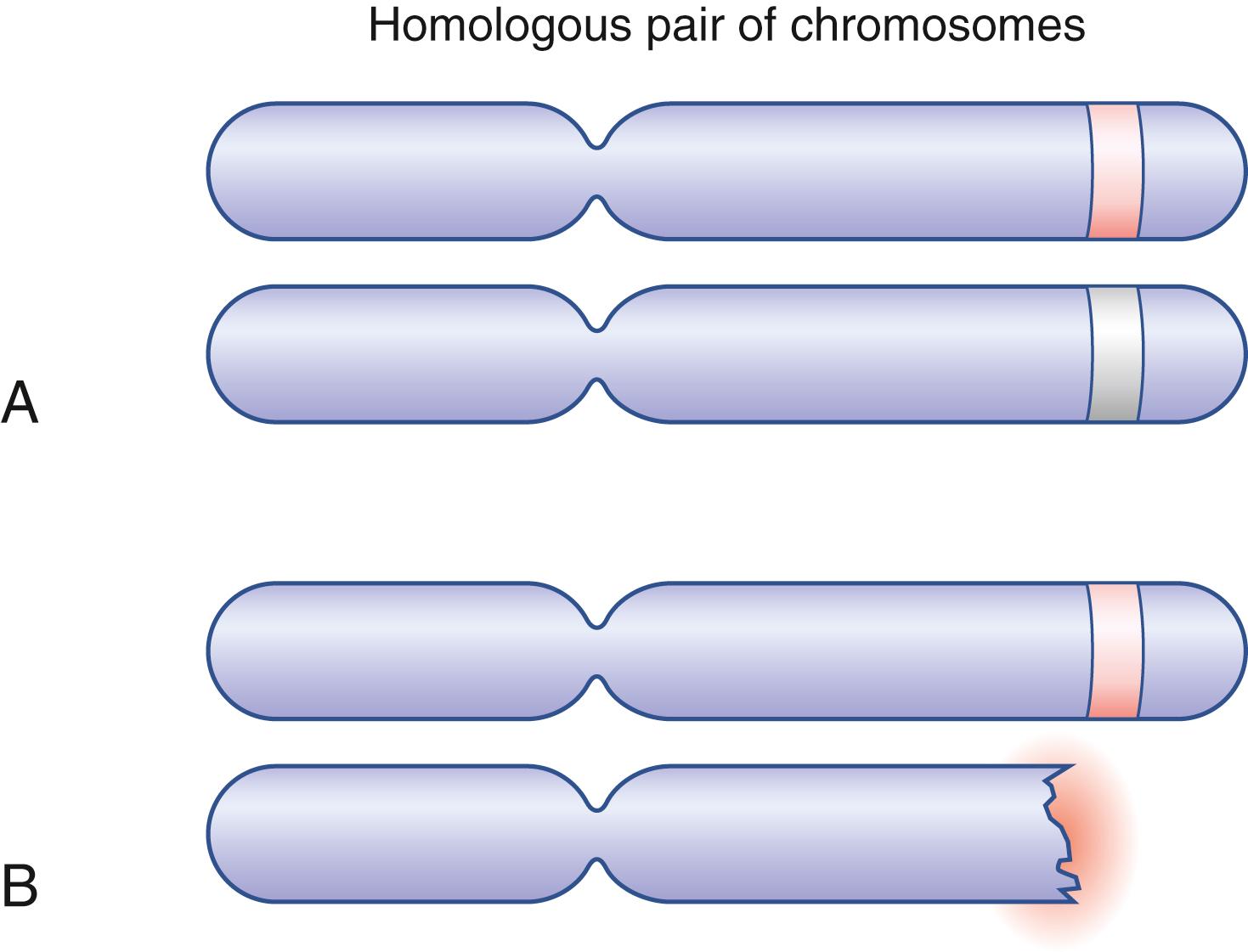
In order to identify the specific mutation, MEN1 families underwent genetic analysis, and MEN1 -associated tumors were specifically studied ultimately localizing the tumor suppressor gene on chromosome 11q13. Gene cloning led to the identification of the protein product of the gene, menin, a 610-amino acid protein. Menin is expressed in endocrine and nonendocrine cells, with varying levels of expression, and is located primarily in the cell nucleus. Through protein-protein interaction methods, the function of menin has been elucidated. These studies indicate that menin has multiple functions in transcription regulation as either a corepressor or coactivator, DNA repair, cell signaling, cytoskeletal structure, cell division, cell adhesion, or cell motility. In addition to its role in endocrine tissues, menin has been identified as playing a role as a pro-oncogenic factor in mixed lineage leukemia ( MLL ) by interacting with MLL-1 fusion proteins to cause leukemia. It has also been identified as having a role in estrogen receptor regulation, and women with MEN1 are at increased risk for the development of breast cancer.
A database of known MEN1 mutations was published in 2008, with just over 1300 mutations identified. An additional 208 were identified after review of the literature and existing gene databases. The distribution of MEN1 mutations includes 20% to 25% missense mutations, 14% to 23% nonsense mutations, 42% frameshift mutations, 10.5% exon region deletion, 9% RNA splice mutations, and 1% to 2.5% large deletions. Genetic changes occur throughout the coding sequence. Somatic mutations occur frequently in nonsyndromic endocrine tumors.
Somatic MEN1 mutations are reported in 60% of glucagonomas, 57% of VIPomas, 44% of nonfunctioning PNETs, 38% of gastrinomas, 35% of bronchial carcinoids, 35% of parathyroid adenomas, up to 19% of insulinomas, 3.5% of anterior pituitary tumors, and 2% of adrenocortical tumors otherwise believed to be sporadic. This suggests that loss of the MEN1 gene plays a role in the development of nonhereditary endocrine tumors as well.
DNA testing of persons who have relatives known to have MEN1 may be performed in order to identify the presence of the mutation and inform surveillance and intervention for the endocrine tumors known to affect these patients. Clinical practice guidelines recommend genetic testing for index patients with MEN1 as well as their first-degree relatives. MEN1 germline mutation testing should also be offered to asymptomatic relatives as manifestations may begin as early as age 5. Given the chance of inheriting the mutation is 50%, identification of a mutation avoids potential unnecessary screening in individuals without a mutation. Newly identified families with MEN1 should undergo testing; however, 10% to 20% will not have a mutation identifiable by conventional testing. For this reason, the diagnosis of MEN1 is made either clinically in patients with two or more MEN1-associated tumors or in a patient with one MEN1-associated tumor and a first-degree relative with MEN1 , a scenario that occurs in 5% to 10% of patients, or in an individual with a known MEN1 mutation but no clinical manifestations. All patients with a diagnosis of MEN1 either clinically or via genetic testing should be offered combined clinical, biologic, and radiologic screening periodically. No genotype-phenotype correlations have been established for MEN1. There are, however, some data that identify mutations targeting the JunD interacting domain of the gene as being associated with an increased risk of death. Additionally, some alterations may predispose the patient to familial PHPT only. Despite more recent identification of these specific mutations, genetic testing cannot be used to predict disease course or severity in affected patients.
Recently, germline mutations of the CDKN1B gene have been associated with the development of parathyroid adenomas, pituitary adenomas, and PNETs, known as MEN4. Clinically similar to MEN1, this may account for persons who meet clinical criteria for MEN1 without possessing a known mutation of the MEN1 gene. Thus far, few pathogenic mutations of the CDKN1B gene have been found and its prevalence remains unknown.
Parathyroid adenomas occur in 95% of MEN1 patients, and PHPT is the first clinical manifestation of MEN1 in 90% of patients. Individuals with MEN1 also develop tumors of the pancreas and duodenum, bronchial and thymic carcinoids, and adenomas of the anterior pituitary gland. In addition, patients are more likely to develop adrenal adenomas and nonendocrine tumors such as angiofibromas, collagenomas, and meningiomas. In patients with MEN1 who undergo postmortem examination, there is involvement of all endocrine tissue in essentially all patients.
MEN1 occurs equally in male and female patients with an autosomal dominant pattern of inheritance without apparent racial predilection. Untreated patients with MEN1 have a decreased life expectancy, with a 50% probability of death by age 50 years. The cause of death is either progression and spread of a malignant tumor that occurs within the syndrome, most often a gastroenteropancreatic NET or thymic carcinoids, or other sequelae of the disease. Historically, ulcer disease as a result of Zollinger-Ellison syndrome (ZES) leads to significant morbidity and mortality; however, this has improved with the introduction of acid-suppression treatment.
The signs and symptoms of MEN1 are attributed to the involvement of a specific endocrine gland or other tissue. These are as a direct result of either hormone overproduction or local effect of tumor or malignant progression of tumors. Most typically, PHPT is the first clinical manifestation, followed by pancreatic islet cell tumors and other NETs. Screening is offered to known kindreds and to those with known mutations, with surgical intervention offered to those with known tissue involvement and hormone excess. An algorithm for diagnosis and surveillance is demonstrated in Fig. 41.2 . The goals of therapy, therefore, are management of hormone excess and prevention of tumor spread.
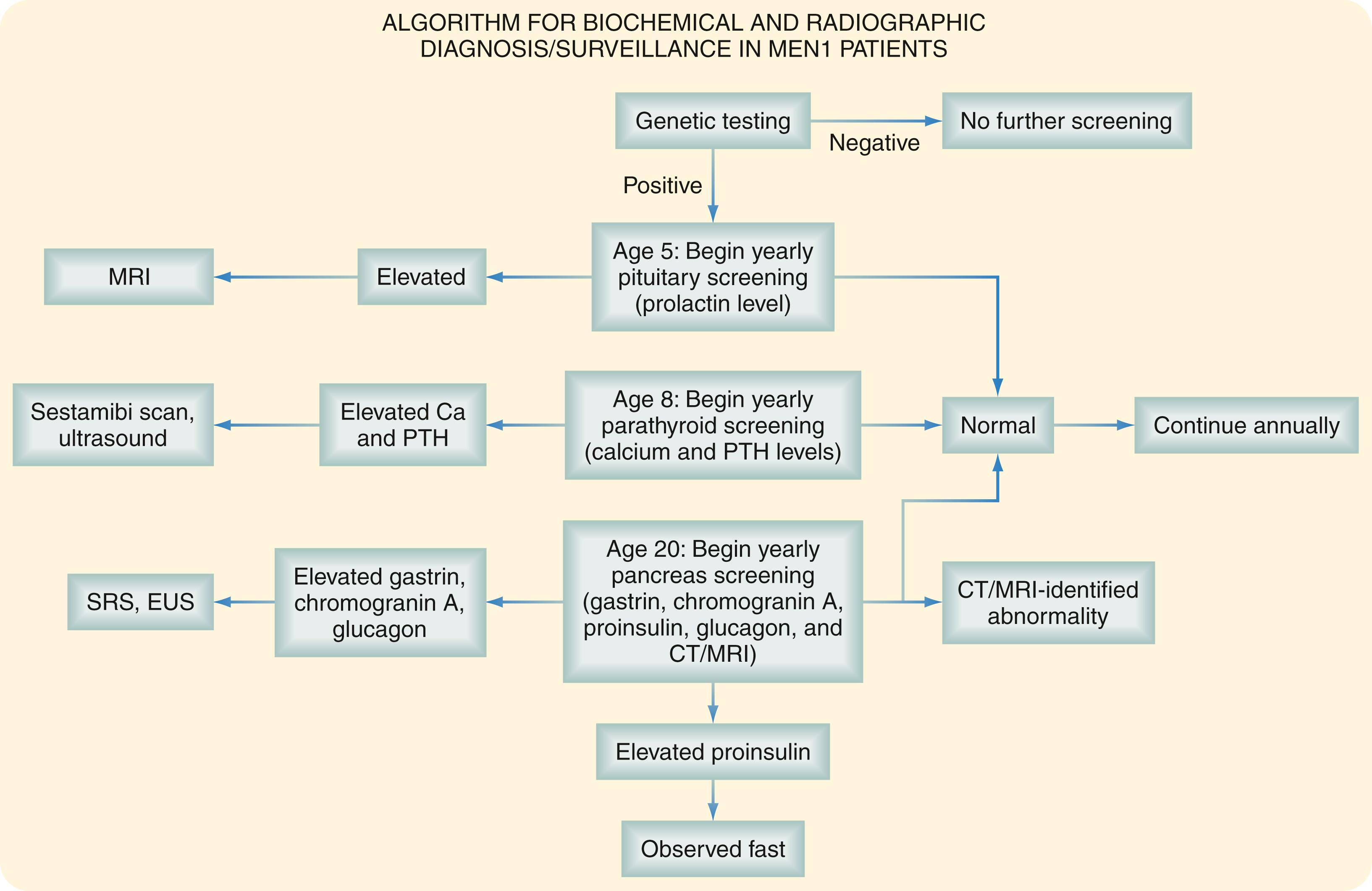
PHPT is the most common feature of MEN1, occurring in more than 90% of patients, and it is the experience of these authors that all patients with MEN1 have PHPT. Like sporadic PHPT, patients may have asymptomatic disease, osteoporosis, nephrolithiasis, or symptoms including fatigue, malaise, polyuria, polydipsia, and constipation. The diagnosis is made biochemically with an elevated calcium and an inappropriately nonsuppressed parathyroid hormone (PTH) level. Compared to sporadic cases, PHPT occurs in the setting of MEN1 at an earlier age (20–25 years vs. 55 years) and an equal female:male ratio (1:1 vs. 3:1). One of the hallmarks of PHPT in MEN1 versus its sporadic form is the presence of multiglandular disease; that is, all parathyroid glands are equally at risk for involvement and asymmetric hyperplasia ( Fig. 41.3 ). Affected parathyroid glands in the setting of MEN1 are typically benign, although rare cases of parathyroid carcinoma are reported.
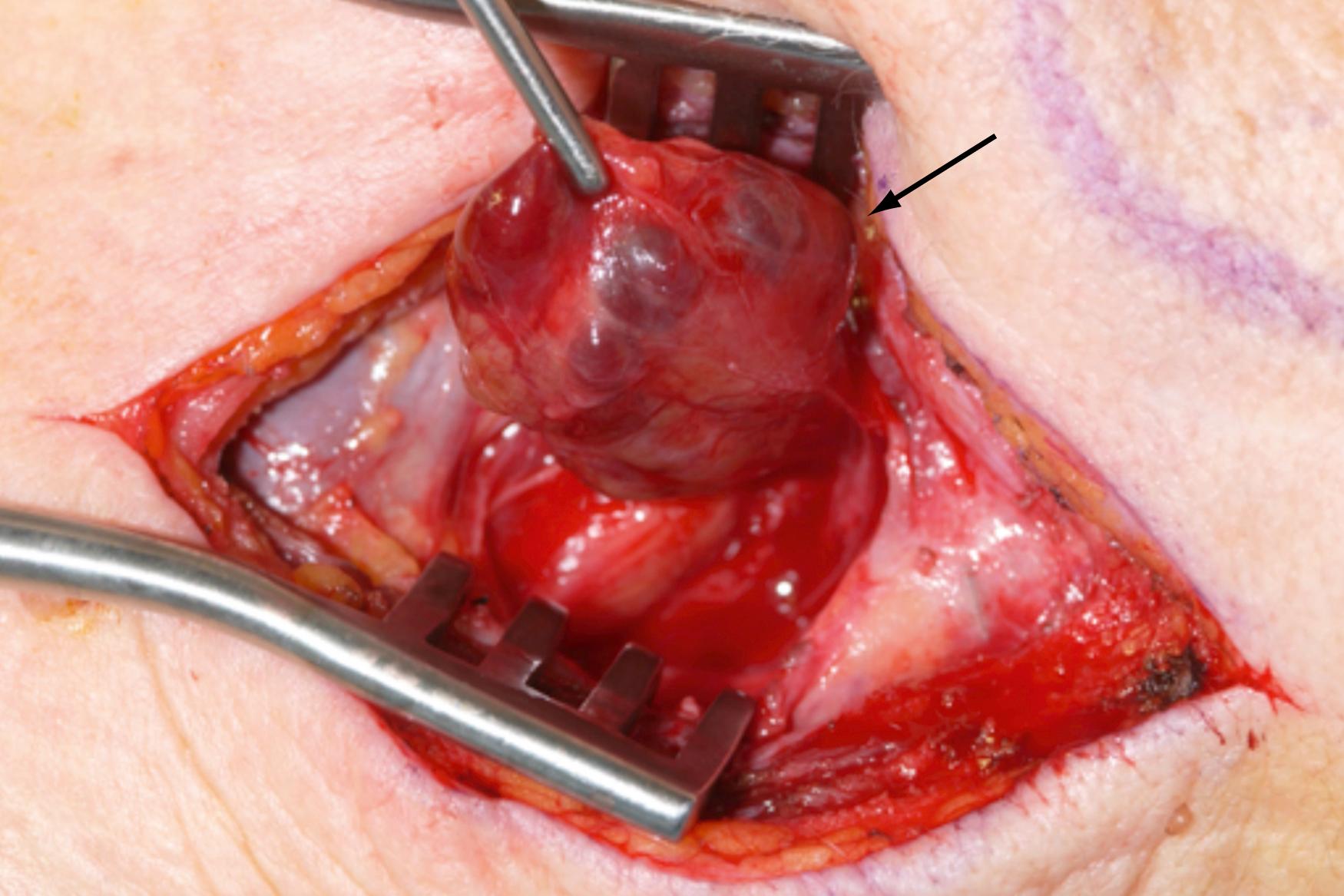
Surgery is the treatment of choice for PHPT in MEN1. While preoperative imaging has been employed in the management of sporadic PHPT, including ultrasound, sestamibi parathyroid scintigraphy, and four-dimensional computed tomography (CT), it may have less utility in familial PHPT. Sestamibi parathyroid scintigraphy may be useful to screen for parathyroid glands that are ectopic from the expected anatomic location in the neck. The recommended surgical approach from the 2012 MEN1 Clinical Practice Guidelines is to explore both sides of the neck via a standard open approach with the goal of identifying all four parathyroid glands. This is the appropriate operation because all four glands are typically affected.
Two operative procedures are options for management: subtotal parathyroidectomy with removal of 3.5-parathyroid glands versus total parathyroidectomy with removal of all four glands along with an autotransplantation of the patient’s own parathyroid tissue into a location outside of the neck, typically the brachioradialis muscle of the forearm. Intraoperative PTH testing may also be used to guide extent of surgery in less than total operations. The goal of surgery is management of hormone levels within a normal range for the longest period of time with limited morbidity. The advantage of a subtotal or 3.5-gland parathyroidectomy is that a period of postoperative hypocalcemia is less likely. Approximately 20% to 30% of patients have either recurrent or persistent hypercalcemia following this procedure within 10 to 12 years, with a rate of hypoparathyroidism of 26% to 45%. The advantage of a total parathyroidectomy with parathyroid autotransplantation is that recurrence rates are lower, ranging from 4% to 20%, but permanent hypoparathyroidism is more likely at 40% to 60%. With either, initial biochemical cure rate is high when performed in experienced groups at 98%, comparable to surgical results in patients with sporadic PHPT. A randomized prospective trial of 32 MEN1 patients undergoing operation for PHPT compared subtotal parathyroidectomy to total parathyroidectomy and autotransplantation. Rates of recurrence were statistically similar, although slightly higher in the subtotal parathyroidectomy group, rates of hypoparathyroidism were similar, and rates of reoperation were similar. Both procedures therefore yield excellent results, but the overall advantage of subtotal parathyroidectomy may be avoiding an initial postoperative period of hypocalcemia. However, if followed long enough, all MEN1 patients will ultimately recur, and, therefore, MEN1-related hyperparathyroidism is never cured, and patients with recurrent disease may need reoperation.
In sporadic PHPT, preoperative imaging is used to guide focused reoperations, but due to the etiology of PHPT in MEN1, focused reexplorations may not be feasible. Using a combination of intraoperative PTH and preoperative imaging, normocalcemia can be achieved in 92%. A strategy to manage hypoparathyroidism after either approach is to cryopreserve a portion of the patient’s parathyroid tissue at the time of initial operation. The cryopreserved autograft may then be transplanted with 60% of delayed grafts, demonstrating some evidence of function with normal PTH levels, and 40% fully functioning off all calcium and vitamin D supplementation. Those patients with recurrence and failed operations or in whom surgery is contraindicated may be treated with calcimimetics as a last option. Vital transplantation may also achieve improved or normal postoperative calcium levels, avoiding hypocalcemia. It may be necessary in cases where a total parathyroidectomy is done at initial operation, or a patient undergoes reoperation and all remaining parathyroid tissue is removed from the neck. Autotransplantation to the brachioradialis muscle of the forearm yields full function in a third of autografts, while an additional 20% are at least partially functional.
Following parathyroid disease, the next most common tumor type to occur in MEN1 patients are enteropancreatic NETs. They occur in between 30% and 80% of patients depending on the study. They may be functional or nonfunctional, that is, some tumors may secrete hormones in excess, yielding symptoms unique to the tumor type, while some do not. Either type has malignant potential, and surgical management, depending on the situation, is aimed at controlling hormone excess, preventing potential metastatic progression, and preventing local invasion. Tumors may secrete gastrin, insulin, or vasoactive intestinal peptide (VIP) and are termed according to the type of hormone secreted, for example, gastrinoma. Hormones also prove to be useful markers for follow-up. While nonfunctional tumors may not secrete hormones in excess, tumor markers such as chromogranin A or pancreatic polypeptide may be useful for follow-up. In contrast to sporadic NETs, MEN1-associated NETs may more often be multiple, and any treatment and follow-up must take this into consideration. Guidelines suggest screening in individuals with a known diagnosis of MEN1 biochemically with gastrin, fasting glucose, insulin, chromogranin A, pancreatic polypeptide, glucagon, and VIP measurements at 6- to 12-month intervals. Any elevation of one of these would then require further investigation with radiographic studies.
There have been many improvements in the imaging of enteropancreatic NETs in recent years, not only as the quality of CT and magnetic resonance imaging (MRI) has improved, but also with the use of alternative imaging methods such as somatostatin receptor scintigraphy (SRS) and the recent introduction of gallium-68 somatostatin analog positron emission tomography ( 68 GaSA-PET). In addition to making an initial diagnosis, imaging also is critical to surgical planning to determine the resectability and appropriateness of surgery in the setting of metastases to lymph nodes and distant organs. Endoscopic ultrasound (EUS) is useful for obtaining a tissue diagnosis and allowing for proper grading of the tumor but may also play a role in follow-up. There is variability of sensitivity and specificity of each modality, but all play an important role in evaluation and treatment.
SRS is nuclear scintigraphy that was once the gold standard for the imaging of NETs. The somatostatin analog octreotide is administered as indium-labeled octreotide, which binds to somatostatin receptors. Sensitivity ranges from 70% to 90%, with a specificity approaching 100%. In contrast to anatomic imaging, SRS has the advantage of being whole-body imaging, and it is also widely available but is limited by resolution and ability to detect lesions smaller than 1 cm. CT is probably the most widely used imaging modality, with similar sensitivity to SRS in the detection of both primary lesions as well as metastases while being slightly better than SRS at detecting extrahepatic metastases. In patients suspected of having an enteropancreatic NET, CT should be done as an early arterial-phase CT. This demonstrates the typical imaging characteristics, where lesions are isodense on precontrast images, then enhance in the arterial phase, with contrast washout on portal venous phase. Compared to other modalities, however, CT has provided the most information with respect to the tumor’s relationship to surrounding structures and aids in surgical planning. MRI is similar to CT in that anatomic relationships are demonstrated but has the advantage of not exposing the patient to ionizing radiation, which may be of concern over a long period of follow-up. MRI done with gadolinium with precontrast, arterial phase, and portal venous phase imaging is similar in sensitivity to CT. On MRI, enteropancreatic NETs are hypo- or isodense on precontrast T1 images and are hyperdense on T2 images with enhancement postcontrast administration. EUS can be very useful in the evaluation of PNETs. A fine-needle aspiration done at the time of EUS provides information to confirm tumor type and establishes grade by obtaining tissue that can be stained and a Ki-67 index determined. While EUS does not provide information regarding distant metastatic disease, it may demonstrate additional detail not seen on either CT or MRI to help determine resectability as it allows for improved visualization of margins with the superior mesenteric artery and other adjacent structures. Duodenal gastrinomas are difficult to see on EUS, and in this situation, traditional visual endoscopy has an advantage.
68 GaSA administered as part of PET is the latest addition for imaging of NETs. 68 GaSA-PET images are also fused with CT to improve sensitivity. Sensitivity is approximately 80% with a specificity of 90%, and specificity approaches 100% for metastases when used to evaluate for disease beyond the pancreas. 68 GaSA-PET/CT detects a greater number of primary and metastatic lesions compared to SRS. In addition to providing useful anatomic information, 68 GaSA may also inform therapeutic decision-making, as PNETs that take up 68 GaSA may predict patients who respond to somatostatin analogs. Sensitivity may be limited by the accumulation of 68 GaSA in the uncinate process of the pancreas or inflammation, which can lead to false-positive studies.
Approximately 50% of enteropancreatic NETs that develop in the setting of MEN1 are gastrin-secreting tumors called gastrinomas. Conversely, 20% of patients with gastrinomas will have MEN1. This produces a clinical syndrome termed ZES, and patients present with recurrent multiple peptic ulcers, abdominal pain, and esophagitis. The disease should be suspected in patients with multiple ulcers that occur in atypical locations, fail to respond to usual therapy, and/or recurrent, or occur in the setting of PHPT. This should prompt evaluation for a gastrinoma. Hypergastrinemia attributed to a gastrinoma is diagnosed by elevated fasting serum gastrin levels greater than 10 times the normal obtained after at least 2 weeks off of a proton-pump inhibitor. If fasting gastrin levels are not diagnostic, provocative testing can be done with secretin stimulation, which is more sensitive and specific than calcium stimulation. Up to 90% of gastrinomas diagnosed within the setting of MEN1 are malignant, and more than half have lymph node metastases. The development of either hepatic metastases and/or lymph node metastases tends to be size dependent, with a greater likelihood of either as the primary tumor is larger. Survival in patients with MEN1 approaches 100% at 15 years regardless of primary tumor size and nodal status, but this is reduced to 52% in the setting of liver metastases.
There is no consensus for the role of surgery in the management of ZES in MEN1 patients. Patients with gastrinomas in this setting rarely achieve long-term eugastrinemia, as evidenced by a review of a series of patients with the disease managed surgically. Further, the availability of proton-pump inhibitors has made medical therapy for control of symptoms possible given that the disease is not curable. In patients with PHPT, surgical correction improves fasting gastrin levels and reduces basal acid output. Therefore, the remaining controversy surrounds the utility of surgery given the malignant potential of the tumor despite the likelihood of long-term biochemical cure. Because most gastrinomas are duodenal, recommendations for management include endoscopic gastroduodenoscopy, duodenotomy and transduodenal exploration, and resection of any malignant-appearing lymph nodes. The typical appearance of a gastrinoma and duodenotomy with palpation of the duodenal wall is demonstrated in Fig. 41.4 . Liver metastases are rare when tumor size is less than 2 cm. Clinical guidelines recommend the surgical approach be tailored to the individual situation incorporating patient preference into the decision-making. The rationale for this approach is based on the likelihood of recurrence given the presence of metastases at diagnosis as well as the potential for development of multiple tumors as well as the high morbidity associated with major pancreas resection. Patients are also at risk for type 1 gastric carcinoids, which develop due to hypergastrinemia and stimulation of enterochromaffin cells. They are present in up to a third of patients with ZES and may be managed expectantly with observation and endoscopic resection, although long-term endoscopic surveillance is necessary.
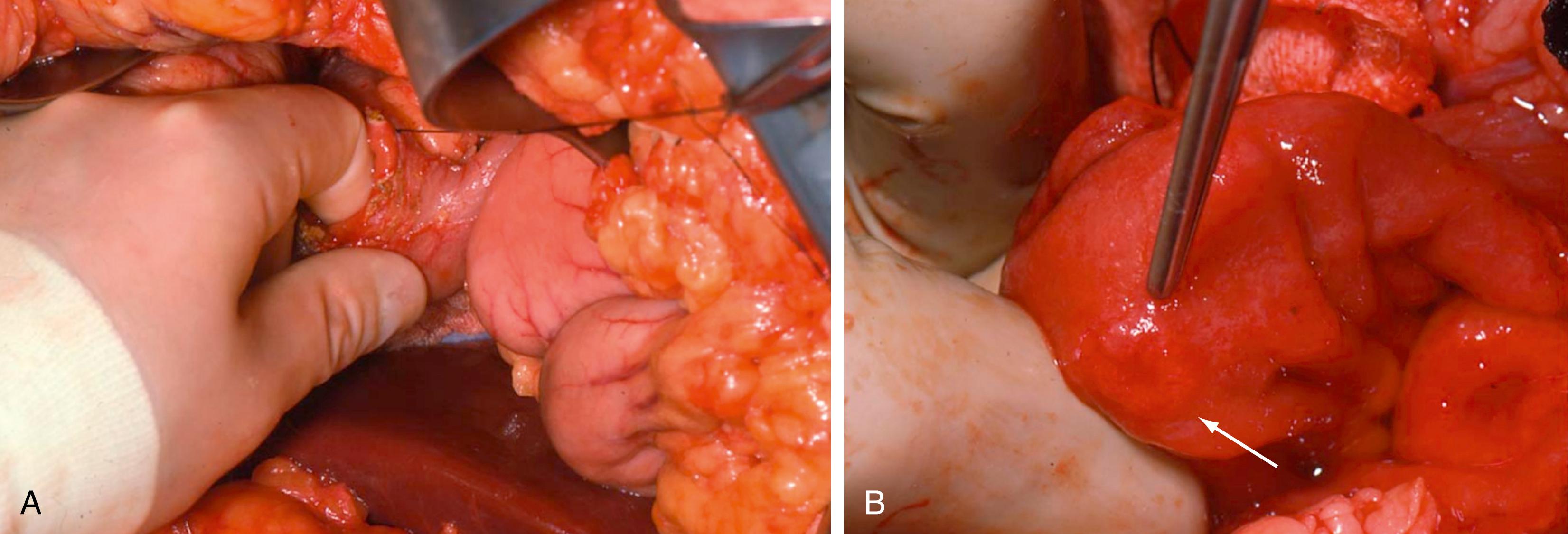
Insulinomas, which are β-islet cell tumors that secrete insulin, represent up to 30% of PNETs in patients with MEN1, while 4% of patients with an insulinoma have MEN1. They present with a constellation of symptoms known as “Whipple triad” including fasting glucose levels less than 50 mg/dL, symptoms of hypoglycemia, and resolution of symptoms upon administration of glucose. These symptoms include sweating, dizziness, confusion, and syncope. Historically, the diagnosis was made during a monitored 72-hour supervised fast where plasma glucose, insulin, and C-peptide levels are measured at 6-hour intervals. An elevated insulin level with a low glucose level is diagnostic. However, data now suggest that a 48-hour fast is adequate and as accurate and should replace the 72-hour fast. Use of oral hypoglycemic agents should be excluded during the duration of the supervised fast. Insulinomas may be multifocal and occur throughout the pancreas and are best imaged by CT and EUS, although they can be difficult to locate and may ultimately be identified at operative exploration with or without intraoperative ultrasound. Anatomic imaging such as CT, MRI, and EUS have varying sensitivities all less than 50%. Calcium arterial stimulation exceeds 90% and is useful in regionalizing the lesion before surgery, and is more accurate than anatomic imaging when used intraoperatively. Intraoperative ultrasound employed in a traditional open or laparoscopic exploration is then used to guide intraoperative exploration with success rates of 86%. Once the suspected insulinoma is identified intraoperatively, aspiration of the lesion and use of a rapid assay for insulin confirm or eliminate the identified lesion as an insulinoma and may be used in addition. Many lesions are amenable to enucleation, but larger tumors or those that appear to be malignant with invasion of adjacent structures may require anatomic pancreatic resection, although approximately 10% are malignant. Fig. 41.5 demonstrates the application of intraoperative ultrasound to surgical exploration in the identification and resection of an insulinoma on the posterior body of the pancreas. Patients with unresectable disease due to either a locally invasive tumor or, more likely, distant metastases may be treated with chemotherapy including somatostatin analogs.
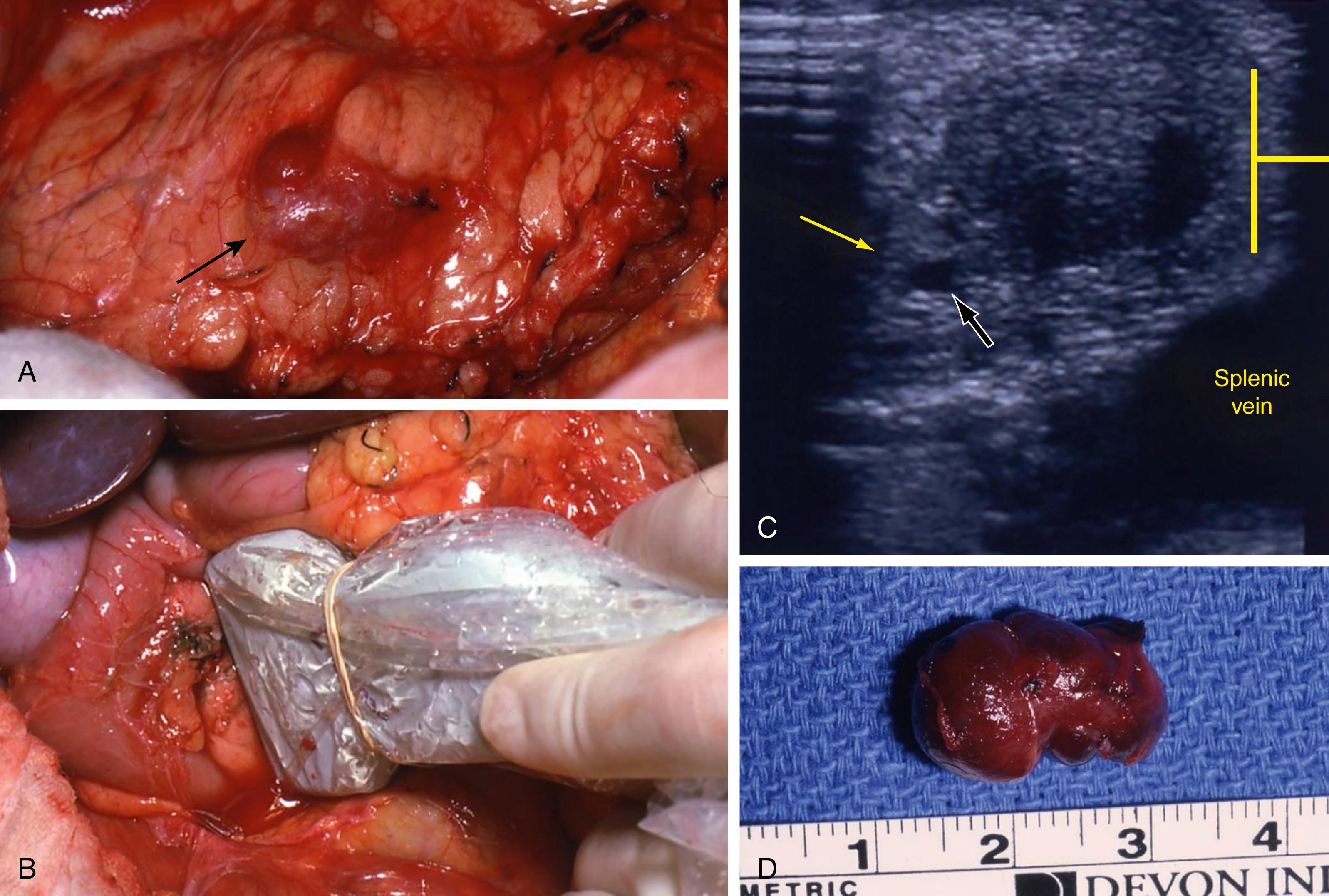
Other functional tumors include glucagonomas, VIPomas, and somatostatinomas, although these comprise fewer than 5% of functional PNETs in MEN1. Symptoms of glucagonomas include a skin rash known as necrolytic migratory erythema, weight loss, anemia, and stomatitis, although a glucagonoma may be present in the absence of symptoms. They most often occur in the tail of the pancreas and surgery is the treatment of choice. They are frequently malignant and 50% to 80% have metastases at the time of diagnosis. VIPomas are infrequent and present with symptoms of severe intermittent watery diarrhea, hypokalemia, achlorhydria, acidosis, flushing, and hypotension. They are often located in the tail of the pancreas and are nearly always malignant. When feasible, they are best managed with surgery. Somatostatinomas also occur infrequently and present with symptoms of cholelithiasis, diabetes, and steatorrhea. They are diagnosed biochemically and treatment is surgical.
The majority of enteropancreatic NETs in MEN1 patients are nonfunctional PNETs, which are hormonally inactive. They are not associated with a clinical syndrome and therefore are diagnosed on surveillance imaging or investigation performed due to the development of symptoms related to local effects of tumor. Screening for enteropancreatic NETs in general should begin at age 10 in patients with known MEN1 mutations. More recent data indicate a correlation between exon 2 mutations and development of nonfunctional PNETs at an earlier age, potentially identifying a group who would benefit from more frequent, earlier screening. Recommendations for surgical intervention are made incorporating two issues into decision-making: the potential for the development of multiple tumors and, therefore, need for multiple operations and the malignant potential of PNETs. Much like recommendations for management of sporadic nonfunctional PNETs, management of familial nonfunctional PNETs is based on size and grade based on mitotic index and Ki-67 index. Observational studies reveal an increasing rate of presence of metastases as tumor size increases. In a group of 108 MEN1 patients with nonfunctional PNETs managed surgically, those with tumors smaller than 1 cm had metastases 4% of the time, tumors 1.1 to 2 cm had metastases 10% of the time, tumors 2.1 to 3 cm had metastases 18% of the time, and if more than 3 cm, metastases were present in 43%. A more recent evaluation of a population of MEN1 patients indicate a relatively increased risk of metastases in tumors exceeding 2 cm. In patients with tumors larger than 3 cm, observation is associated with increased mortality and development of metastases compared to those who had surgery, while the benefit for those with tumors 2 to 3 cm was less clear. Those with tumors less than 2 cm had no clear benefit from surgery. The current consensus recommendation is that tumors less than 2 cm should be observed with imaging at regular intervals. A decision to proceed with surgery should also be made in patients with tumors that demonstrate significant growth after interval imaging, apparent development of metastases, or if patient-specific factors make observation less desirable. Observation and expectant management for patients with tumors smaller than 2 cm should be recommended given the morbidity surrounding pancreatic surgery.
Become a Clinical Tree membership for Full access and enjoy Unlimited articles
If you are a member. Log in here